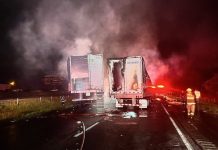In the wake of last week’s deadly shootings in San Bernandino, California, Columbus law enforcement officials are reassuring residents that local police officers are well-equipped to keep the city safe.
Before the deadly 1999 shootings at Columbine High School in Colorado, police officers were trained to wait until SWAT teams arrived on the scene of an active-shooter situation before entering a building and trying to take a shooter down, said Sgt. Matt Harris, spokesman for the Columbus Police Department.
However, after 12 students and one teacher were killed by the armed students at the school, police forces — including Columbus — began training all officers, not just SWAT officers, to respond to an active-shooter or other mass-casualty situation, Harris said.
“We can’t wait in those situations,” he said.
All 83 police officers currently on the Columbus force have gone through an eight-hour training course on what to do in case of an active shooter, Harris said. Officers are also required to go through a yearly recertification process to keep their skills relevant and up-to-date.
The training is slightly different each session to equip law enforcement personnel to respond to a variety of situations, which could include a school shooting, a bomb threat or any other situation where there is a potential for mass casualties, Harris said.
The most recent recertification for Columbus police officers was just a few weeks ago.
Additionally, about a fifth of all Columbus officers are military veterans, Harris said. Although police work and overseas military service are different, Harris said veterans are trained to respond calmly in high-stress situations, which is why the department often looks to hire veterans onto the force.
If a mass-casualty situation were to occur in Columbus — a scenario Harris called highly unlikely — reinforcements from the sheriff’s department, Indiana State Police and possibly even federal law enforcement agencies would be called in to help, Harris said.
“It would be an all-hands-on-deck situation,” he said.
The Columbus department also calls in outside help when the city hosts large events, especially the Mill Race Marathon each September.
State Police officers come to Columbus to direct traffic and serve as extra pairs of eyes in the large crowds, and SWAT teams are deployed throughout the city to respond in case of an emergency.
Bartholomew Consolidated School Corp. also is taking steps to ensure students will be safe if an active shooter were to enter a school.
Columbus police officer Julie Quesenbery and patrolman Eric Stevens were hired in 2014 as school resource officers for the district. Quesenbery is stationed at Columbus East High School and Central Middle School, while Stevens works out of Columbus North High School and Northside Middle School. They are each assigned to cover nine school buildings.
Both Quesenbery and Stevens are trained to respond to an active shooter in the schools, Harris said.
Additionally, Larry Perkinson, the school district’s student assistance coordinator, and Kelli Thompson, director of student health services, met with local emergency response personnel on Thursday to discuss ways school nurses could help emergency responders in a mass-casualty situation.
Thursday’s meeting had been planned for at least a month and was not in response to Wednesday’s shootings in San Bernandino, Perkinson said.
Every school in the district has either a registered nurse or licensed practical nurse staffed in the building, Thompson said.
The group agreed that trained emergency responders would likely be best equipped to care for any injuries that result from an active shooter or other emergency situation.
However, school nurses have a better knowledge of the inner workings of the school buildings, so they could facilitate rescue and recovery efforts by helping to identify students and staff and pointing first responders in the right direction.
Additionally, district nurses could set up preliminary triage stations to begin initial care while they wait for ambulances to transport the injured to hospitals.
Ultimately, school officials agreed that the next best step in strengthening their emergency response plans would be for Thompson to coordinate with city and county EMS teams to ensure school nurses and first responders receive similar training on how to handle an active-shooter situation.
Although the threat of a mass-casualty situation in Columbus might seem more imminent as residents hear about recent shootings around the country, Harris said the people of Columbus should rest assured that police officers are prepared to react to a large-scale emergency situation.
In a moderately sized city like Columbus, its police department is lucky to have a bomb squad and special tactical teams to protect residents, Harris said. With those teams in place, he said, the city is poised to respond if needed.
“We’re prepared,” he said. “Our officers train for the worst.”




